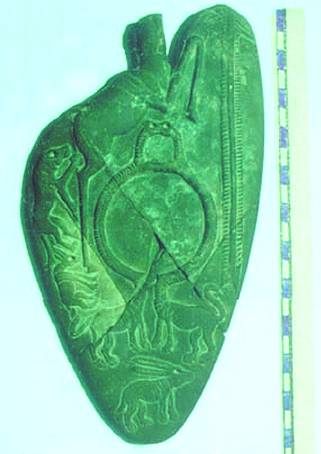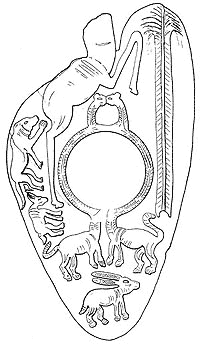|
|
|
|
|
|
Description
Minshat Ezzat palette
(Manshiyet el-Ezzat)
Minshat el Ezzat t. 82 (area A1 - sect. 10)
h. cm. 23,6
Bibliography
Salem Gabr el Baghdadi: La Palette decorée de Minshat Ezzat ... una
palette decorée en contexte archaeologique, Archéo-Nil 9, 1999,
9-11.
El-Baghdadi, El Said Nur, in: Cialowicz, Chlodnicki, Hendrickx, Origin
of the State... 2002, Proceedings in press (2004)
S. El-Baghdadi, Proto and early Dynastic necropolis of Minshat Ezzat, Dakahlia
province, Northeast Delta, Archéo-Nil 13, 2003
Z. Hawass, National Geographic Jan 2003, Italy (full page photograph of the
decorated side of the palette)
Links
http://guardians.net/sca/Monshaet_Ezzat.htm
http://www.ahram.org.eg/weekly/2000/468/tr4.htm
... ... ...
Salem Gabr El Boghdadi, chief archaeologist of the area and the responsible
of the pre mentioned excavations is fascinated by the unearthed alabaster,
shiest and arduous utensils, the plates in different size and shapes, but
the masterpiece is that beautiful knife bearing Den's serekh. Den was the
fifth king of the first Dynasty that ruled Egypt and the serekh was the shape
that included the king's name and was developed to become the cartouche. Some
of his remains are actually displayed in Cairo Museum. Hor, on top of the
serekh is represented as a falcon to express the fact that Den was a powerful
king and that he, as a ruler, was strong and his reign a particularly characteristic
and prosperous. Amongst the unearthed objects a cylindrical seal bearing Hieroglyph
inscriptions that might represent the owner's title or his position, the signs
smr-sk3mr.sb3 might probably design the combination of the soul and the ba
according to the SCA archaeologists who worked hard to unearth properly these
valuable items. The discovered palettes are very few and don't exceed ten,
but the actually unearthed palette is exclusively beautiful in its designs
as it represents animals. The palette was restored as it was broken into
four parts, but thus repaired it looks almost complete. The rare symbols inscribed
denote its reference to the Old Kingdom. The inscriptions reveal a hunting
dog pursuing an elegant animal that looks like a jumping gazelle trying to
run away from the dog. That dog is also followed by an animal looking like
a gazelle but in a peaceful attitude; this attitude, according to the area
manager Ibrahim El Saidi, denotes peace and tranquility that were characteristic
of the reign during this period. The two animals represented in a unique position
are the symbol of the unification between Upper and Lower Egypt; the two animals
facing each others hold their tails in an upright position. Their long necks
interlace in a mythological appearance; this embrace is a significant sign
of the unification. The animals' nails are reproduced with the other animal
represented at the lower part of the palette, its an animal with long ears
and a tail lying at his back and standing in a very peaceful position. A feather
that looks like a palm tree is depicted to the furthest right of the palette
whose general shape is the representation of a heart completely intact apart
from the upper left part that is missing. The palette still needs a long study
in order to interpret properly the significance of the pre mentioned symbols,
as they might relate a specific event or simply a story like the other ten
discovered palettes referred to the same period and found at various dates.
Generally speaking the interpretation of the SCA archaeologists is that the
palette relates a certain struggle that had existed in the area and was followed
by unification and peace. This struggle occurred during Den's
regency known as king of Upper and Lower Egypt during the first Dynasty whose
founder was the famous Mena, Mena palette is actually exhibited in Cairo Museum
in a prominent place. Dr.Gaballah Ali Gaballah, Secretary General to the
Supreme Council checked on the site the progress of the works there and said
" we hope to discover more and more tombs related to this period that goes
back to five thousand years. We also hope that we can find more exclusive
and rare findings related to that important period of our history as excavations
reveal the consecutive and continuous progress of civilization over these
important spots in Egypt's land. We can easily notice, through the perpetual
use of a specific necropolis the evolution steps occurred in the Ancient Egyptian
Civilization. I praise the efforts of the SCA employees in the Egyptology
Department supervised by Dr.Mohamed El Soghayar". Monshaet Ezzat, El Senbellawein,
Dakahlia governorate is only part of a series of important archaeological
sites covering various ruling Dynasties periods. Tell El Rabee is a 230 feddans
surface including pharaonic relics and monuments such as temples, compartments,
granite naos, mastabas, rams necropolis with huge granite sarcophagi.etc.
Tell El Balamoun, 158 feddans was Diospolis Parva during the Ptolemaic reign
and was mentioned in important documents, in Edfu texts she was the capital
of Behdet Nome. Many important sites cover not only Dakahlia governorate but
also the whole Delta area and are subject of great interest from the SCA and
the foreign working missions acting in Egypt.
URL: http://guardians.net/sca/Monshaet_Ezzat.htm
Note that these palettes, which have already been hypothesized as possibly provincial (Delta) pieces, are generally considered to be of Naqada III date, thus predynastic; the occurrance here with objects of Den might also mean that this piece was already some 200-250 years old when buried, but certainly if more of these objects were found in a similar middle Ist dynasty archaeological contexts would completely change the chronology of these pieces. (F.Raffaele)

